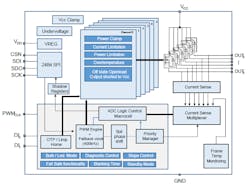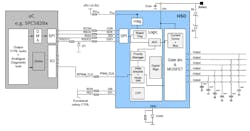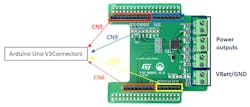Go to an antique-auto show—say, one for cars at least 25 years old—and you’ll see relatively little “electronics” content in the vehicles. The terms ADAS (advanced driver-assistance systems) and infotainment hadn’t been devised yet and self-driving cars were mostly conjecture with some basic R&D efforts underway. The few “advanced” functions in these cars, such as power windows, power seats, or heated seats (if they were even offered) ran directly off the 12-V battery of the car and were controlled by “hardwired” on/off switches. The only in-vehicle network was that 12-V rail.
Zip ahead to today’s cars and things certainly have changed. Whether mainstream ICE (internal combustion engine), some version of HEV (hybrid electric vehicle), or pure EV, electronics and advanced electromechanical systems of all types are located throughout the vehicle—all linked by low-, medium-, and high-speed networks.
Inductive loads such as power-assisted accessories and power windows, and resistive loads such as heated seats aren’t driven directly. Instead, they’re controlled by a network, smart controller, and power driver, with the latter almost always in a high-side arrangement due to the difficulties of having ungrounded loads in a car.
Meeting the complicated and growing demands on that driver function is where the VN9D30Q100F (Fig. 1) and similar VN9D5D20FN multichannel drivers with SPI (Serial Peripheral Interface) connectivity from STMicroelectronics play a vital role. The former is a six-channel device with two 33-mW and four 90-mW channels, while the latter is a four-channel device with two 7.6-mW and two 20-mW channels.
These automotive-focused intelligent drivers (AEC-Q100 qualified), claimed to be first with digital current sensing among its many fully digital on-chip diagnostic features, are designed for high-side connection in 12-V battery systems. (Note that despite the growing adoption of higher voltages such as 48 V, there’s still a widespread need for the classic 12-V rail.)
These high-side driver ICs with 24-bit SPI simplify the hardware and software design of electronic control units (ECUs) and enhance system reliability. The new devices are based on ST’s latest-generation of VIPower M0-9 technology, combining an efficient 40-V trench vertical MOSFET with 3.3-V digital logic and high-precision analog circuitry in a 6- × 6-mm QFN package.
The attributes of the drivers fall into three categories: general features, diagnostic functions, and protection. Among the many general features are capability of extreme low-voltage operation for deep cold-cranking applications; 10-bit ADC for digital current sensing; a pulse-width-modulation (PWM) engine with independent phase shift and frequency generation for each channel; programmable bulb/LED mode for all channels; and advanced “limp home” functions for a robust fail-safe system. In addition, the devices are optimized to minimize electromagnetic emissions and exhibit very low electromagnetic susceptibility.
Among its diagnostic functions are digital proportional load-current sensing; synchronous diagnostics of overload and short to ground, output shorted to VCC, and OFF-state open-load; and programmable case-overtemperature warning. To deal with the harsh automotive environment, always-important protection features include two levels of load-current limitation; self-limiting of fast thermal transients; undervoltage shutdown; overvoltage clamp; load-dump protection; and protection against loss of ground.
The company’s comprehensive 100-page datasheets contain the necessary basic performance specifications under various operating conditions, as well as numerous state diagrams, flow charts, timing diagrams, register and bit assignments, thermal data, and pinouts. There’s also a useful system-level overview of these devices in an application (Fig. 2).
A basic single-IC VN9D30Q100Fevaluation board is available, too (Fig. 3).
Both ICs are available now; the six-channel VN9D30Q100F is priced at $1.070 while the four-channel VN9D5D20FN goes for $1.563 (orders of 1,000 pieces).



